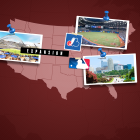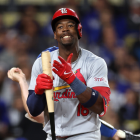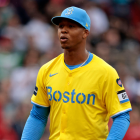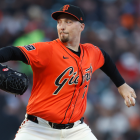In the late 1960s, Major League Baseball had more blemishes than it could cover, including dwindling crowds, sluggish play and a broad sense from all quarters the game used to be better. As a remedy, baseball turned to its favorite elixir: expansion. With the start of the 1969 season, baseball introduced the Kansas City Royals, Seattle Pilots, Montreal Expos and San Diego Padres. Not everyone welcomed them warmly. Hall of Famer Dizzy Dean, then in his 50s, grumbled about a comeback since "they bring anybody up to the majors nowadays."
Dean wasn't the only skeptic. Expansion bumped the total attendance figures, but the per-game average dipped for a third consecutive year. Fans seemed over the in-person experience. Ford Frick, baseball's commissioner until 1965, appeared prophetic when he had warned the owners earlier in the decade against adding too much, too quickly -- a sentiment not shared by the congresspeople who petitioned Frick's successor, William Eckert, to create three additional teams in time for the '69 season. Eckert declined, blaming the ongoing expansion efforts and the military draft as having "greatly limited the availability of professional baseball talent."
Los Angeles Dodgers president Walter O'Malley, meanwhile, was concerned about a different brand of sparseness. He felt expansion would "exhaust every community with enough money to build a stadium." O'Malley meant domestically -- he envisioned future expansion occurring abroad, beyond the borders of the United States. Expansion to the people in charge was no more than a business transaction; to the fans, it was a chance to claim part of America's pastime as their own.
Baseball has since added six teams without venturing farther outside the continental U.S. than Canada. The last round of expansion, more than 20 years old, resulted in the creation of the Arizona Diamondbacks and Tampa Bay Devil Rays (now just Rays). It seems unlikely baseball will go two more decades without adding -- especially since the National Football League and, as planned for 2021, the National Hockey League have each expanded to 32 teams during the interim period. Baseball's conditions would appear sub-optimal for expansion. There are countless issues to reckon with, including the potential for a work stoppage in the coming years. The similarities between where baseball is now and where it was in the '60s, when the league decided the more the merrier, suggests the possibility shouldn't be overlooked.
Commissioner Rob Manfred has done his part to sell expansion as a credible option. Every six months, he names a handful of markets, only to postpone the courtship before setting a date. Manfred is careful to attach caveats, having laid the groundwork for future negotiations. Those hopeful cities must remain limber without being assured action. They are baseball's bullpen, to be acknowledged when and only when they're needed. MLB, to paraphrase the song, wants hopeful markets to be green, mean and everything more -- to be willing to take the leap of faith in building a stadium without first being awarded a team, either through expansion or relocation.
Expansion is an industry upon itself -- then and now -- with factories hard at work in Portland, in Montreal, in Raleigh and elsewhere. These cities, with varying degrees of justification, are chasing their big-league dreams. The problem with dreams is even the best tend to evaporate when met by the pale light of budgets, laws and practicality. Expansion is baseball's biggest inspiration, bringing hope of a major-league tomorrow to unsettled lands, and its biggest racket. Whether pro or against, understanding expansion is a must -- for it will loom as a possibility until it again becomes a reality.
On the edge of the Willamette River in Portland, Oregon, downstream from the Fremont Bridge, there's an old shipping terminal. It's about 100 miles from Mount Hood, the tallest point in the state, and a 10-minute drive from what used to be named the Rose Garden, where the NBA's Portland Trail Blazers play their home games. Terminal 2 is owned by the Port of Portland and stretches 45 to 53 acres, depending on the estimator. The terminal no longer stores marine cargo. These days, it's a set of "vacant parking lots and unused cranes and empty warehouses." If a local group succeeds, Terminal 2 will soon be home to a major-league team.
The Portland Diamond Project is fronted by Craig Cheek, a longtime Nike executive whose biography has him spending some time in the movie/media content space. Ex-Trail Blazers play-by-play person Mike Barrett serves as managing director, while local former big-leaguers Dale Murphy and Darwin Barney are baseball consultants. R&B star Ciara and her husband, Seattle Seahawks quarterback Russell Wilson, headline the group's investors list. Leveraging celebrity is one way PDP has gained credibility. Another way is with a sleek website where fans can purchase Pride- and Independence Day-themed swag, much the way they might through an existing team's store. In lieu of buying tickets, Portland fans can gaze at ballpark concept images, complete with millennials snapping selfies on the boardwalk, the garden roof deck and in the gondola suite -- yes, the gondola suite.
"It's all about exceeding the fans' expectation," Cheek told CBS Sports. "Part of that is tapping into where our fans want to experience the game, so we've got a lot of ideas -- especially with our quirkiness that Portland's known for, and our youthfulness. We think we can actually be a great thought leader and a great incubator for Major League Baseball to push the fan experience and really grow the game with the next generation."
Cheek is quick with the buzzwords and with facts about Portland's baseball past. The Rose City's history with the game dates back to the 1860s. Ted Williams, among others, played at Vaughn Street Park. The No. 1 pick in June's draft, Oregon State catcher Adley Rutschman, wowed scouts about 90 minutes from where PDP hopes to hang the gondolas. Portland may have lost the Triple-A Beavers earlier in the decade, but Oregon houses three teams in the Northwest League: Eugene, Hillsboro and Salem-Keizer. Baseball has a place in Portland, the reasoning goes, because baseball has always had a place in Portland. Even the pursuit of a big-league club is nothing new: Portland tried to lure the Montreal Expos before they were delivered to Washington, D.C. in September 2004.
David Kahn, best known for his rocky tenure as Minnesota Timberwolves general manager, was behind the effort to land the Expos. Cheek seems unbothered by Kahn's misfire, and by people asking how this attempt at a big-league christening is any different. "We don't look at that as a failure. We look at it as if it wasn't our time but now it is," he said. "Fast forward 15 years, the city has grown exponentially. The corporate support is here. The fan base is here."
Portland's passion for its three professional teams -- the Blazers, Timbers (MLS), and Thorns (NWSL) -- can be verified objectively. The Blazers drew more fans per game last season than the big-market behemoth trio of the Los Angeles Lakers, New York Knicks and Boston Celtics. The Timbers packed in more than 20,000 fans per game, while the Thorns have exceeded 16,000 devotees per game in each of the past two seasons -- a remarkable accomplishment given only one other team in the National Women's Soccer League drew more than 6,000 per game. (The Timbers and Thorns' success even precipitated a 4,000-seat expansion at Providence Park.) Cheek refers to Portland as an "underserved city" multiple times throughout the conversation, and what he means by that is the demand for professional sports exceeds the supply.
Other pluses working in Portland's favor include a larger television market than Nashville, Las Vegas and most American cities vying for MLB's attention. The aforementioned potential for corporate support shouldn't be overlooked, either. Cheek refers to Portland as the "sports, athletic, and outdoor industry epicenter capital of the world" due to the city serving as home to headquarters of apparel giants Nike, Under Armour, and Columbia. "When we look at the market, just all the indicators are we're a very, very viable market for Major League Baseball," he said.
The indicators may paint a rosy picture of Portland's viability, but there are thorns to be found.
Building a stadium requires a confluence of skill, planning and luck, similar to building a championship roster. To succeed, one needs good location, financing, zoning and infrastructure. Not every stadium built checks each box. But then, most stadiums are built for existing teams. Those groups trying to convince MLB to let them in through expansion have to prove their competency somehow. Landing a park is essentially the final exam.
Portland didn't obtain the Expos, but the efforts did lead to a bill being passed promising up to $150 million in public financing toward a stadium once a team was acquired. Most of the money would be collected from the income taxes of the players and officials. Businesses within a certain distance would contribute through licensing fees and revenue sharing. In the past year various Oregon Democrats, including Senate Majority Leader Ginny Burdick, have stated their intent to repeal the bill as public financing of stadiums has grown less popular with voters over the past decade-plus. If and how PDP would finance its billion-dollar riverside park -- complete with boardwalk, garden, gondolas, and a retractable, translucent roof -- in the event the $150 million is dashed remains unclear.
The possibility of losing funding hasn't prevented Cheek from articulating an ambitious view of the future.
"With the trends that we're seeing, like with the Battery in Atlanta, these ballparks can truly be transformational for a bigger idea than just baseball," Cheek said, referring to the Braves' controversial compound. "We're looking at this becoming the new neighborhood, the new district, the new hub for Portland, where it all comes together; work with play. We can see thousands of housing units. We can see mixed-use retail. We can see restaurants on the water. We can see artisans and maker spaces and small Portland companies being headquartered in this district."
Cheek's vision may prove overzealous for the proposed Terminal 2 site. There are considerable zoning and transportation hang-ups for PDP and the city of Portland to navigate. The stadium would sit two miles from the nearest light rail station, and wouldn't offer great access to buses or the freeway. Water taxis zipping across the Willamette could alleviate some of the bottleneck effect, but getting more than 30,000 devotees in and out in a reasonable time would seem to require additional infrastructure -- and years of planning, and oodles of cash. PDP has since negotiated a six-month extension with the Port of Portland on its due diligence period.
A lengthy delay would be a sub-optimal outcome for PDP, which is racing similar groups across the continent. If there is an upshot, it's how every market has pluses to trumpet and minuses to mutter. "It's like choosing a fighter in Mortal Kombat," said urban designer Josh Frank, who is located in the Tampa Bay area and consulted with the Rays on a ballpark as part of his college coursework at the University of South Florida. "All these metro areas have categories, some of them are higher and some of them are lower, and it's about trying to choose the right fighter. You try to find one that probably has a little bit of everything and isn't very heavily weighted in one or two categories."
Identifying a stadium location can feel like picking between Sub-Zero and Scorpion, too. PDP's selection of Terminal 2 demonstrates how challenging the task is -- even for the well-connected and well-incentivized.
In an ideal world, the team would stumble upon a large, vacant lot in a densely populated area adjacent to restaurants, bars, and tourist destinations. The surrounding neighborhood would offer sufficient access to trains and buses and would be safe enough to be deemed walkable, easing the burden on developers by removing the need for endless parking lots. The stadium site would sit within hollering distance of corporate sponsors, whose executives could root for the home team every night after work just as soon as the company dished out for costly suites.
Finding a pre-existing location with those attributes is as common as finding a Joshua tree in the rainforest. Teams have adapted to this reality by building districts of their own -- be it the Battery, or Texas Live!, a bar/restaurant/shopping complex built adjacent to the Texas Rangers' new ballpark opening next year. The "mixed-use" approach so often touted by owners is more beneficial to the teams in the long run, anyway. As Frank notes, teams can make greater profits by developing then selling the land. The stadium becomes a secondary motivation -- the bait for others, not the score. Alas, teams having control over what -- and who -- is next door creates further complications. "What these teams are trying to do is create their core demographic in a district," Frank said. "White male, medium to high income, tech-oriented."
Almost as if on the beck of a league-wide directive, baseball has taken to prioritizing the upper-class fan above all. This is an affluent individual who can shell out for tickets, gear and food without worrying about their budget. Teams have all but admitted as much publicly. In 2015, an executive with the Los Angeles Angels said, "We may not be reaching as many of the people on the lower end of the socioeconomic ladder, but those people, they may enjoy the game, but they pay less, and we're not seeing the conversion on the per-caps." The executive later resigned.
Cheek wasn't hinting at these socioeconomic elements when he referenced the Battery, but the desire to appease the wealthy can and has already influenced where stadiums are being built -- and who they're being built to accommodate. The Braves were the first team in 40 years to move from downtown to a suburb. In doing so, they relocated from a predominantly black neighborhood to one mostly white. The move brought the Braves closer to their season-ticket base, yet clashed with their stated preference for better public transportation. It remains unclear how moving to a more remote area helped. (The neighborhood where Portland wants to build its ballpark had the lowest average income of any in the city, per data from 2009, which raises its own potential problems.)
If established teams -- ones with large fan bases owed to decades of national television exposure -- can be impelled by impure motives, then surely so can unlaunched franchises. As John Helyar concluded in "The Lords of the Realm," now some 25 years ago, the expansion process is all about who can "fork over the most money."
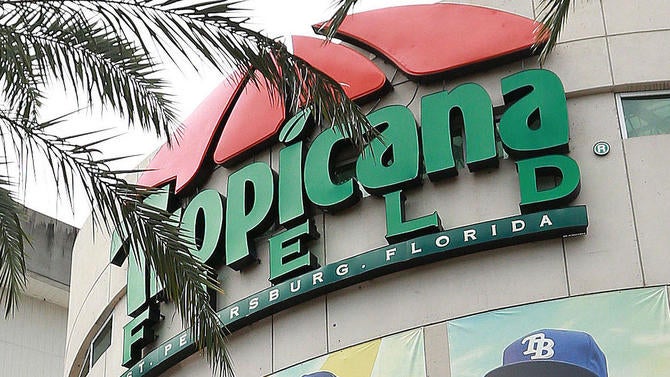
Portland's pitch for expansion is a compelling one -- particularly the potential for ravenous crowds and lucrative corporate sponsors. The team would need their local backing to be strong, too, because the minute it came into existence it would join the ranks of the small-market teams. For comparison's sake, Portland's TV share is smaller than Cleveland's, which has provided the best- and worst-case scenarios over the past couple decades. The best: Portland sells out its riverside paradise for years upon years, the way Cleveland did with Progressive Field; the worst: Portland's ownership handcuffs its front office with budgetary restraints, even after the group assembles a pennant contender.
Market share isn't a problem exclusive to Portland -- or to Nashville, or to Las Vegas, or to any other American city with seamhead aspirations. Almost anywhere baseball expands in the coming years will rank in the bottom half to bottom third of TV markets. Therein is part of the argument against expansion. Why should owners make room at the table, reducing their share of the profits and the talent, to add more small-market teams? The answer might be as simple as the instant gratification offered by an exorbitant expansion fee.
Back when the Diamondbacks and the Rays joined MLB, each group had to pony up $130 million. The fee would likely be multiple times higher now. Seattle's NHL franchise is having to pay $650 million to join the league. MLB's revenues are believed to be more than double the NHL's, meaning its expansion fee could top $1 billion. Multiply by two, divide by 30, and owners could pocket nearly $70 million apiece. What the owners and the league as a whole must answer is whether $70 million is worth it -- not just to share the pie, but to use another plate.
One tried-and-true method teams use to land stadiums is threatening to move elsewhere if they don't succeed. With MLB angling for new homes for the Rays and Oakland Athletics (and saying expansion won't occur until after those teams are squared away), and beginning the process for the Diamondbacks and Los Angeles Angels, maintaining a vacancy in a viable market could pay dividends. To the untrained eye, such an approach appears nonsensical, a waste of fertile soil. But the NFL did something similar with Los Angeles over that city's 20-year absence from professional football. "One of the things that helped NFL teams immensely over the last generation, until just the last couple of years, was having Los Angeles open," said Michael Leeds, the chair of the economics department at Temple University. "Any team that wanted to renegotiate the stadium deal, or wanted a new facility built -- all they had to do was mention the words Los Angeles, and the city would have to take notice."
The Tampa Bay area being on the other end of these talks is evidence of a humorous universe, because Tampa Bay used to be MLB's best port for delivering new stadiums to its teams. Leeds tells of a potentially apocryphal story from the pre-Rays era. In the story, a marketing executive is meeting with baseball owners. The executive tells the owners he's going to show them a picture of the game's most important stadium. He reveals a photo of Tropicana Field. "But there's no team there," the confused owners object. "Exactly," the executive replies.
The implication is as clear as the bay water: Leverage is God's gift, making Tampa Bay manna from heaven.
According to Bob Andelman's "Stadium for Rent," the region missed out eight times before landing the Rays. One close call came in the '80s, when Chicago White Sox owner Jerry Reinsdorf threatened to take his ballclub south if he didn't get a new playhouse. Reinsdorf later placed his cards face up in an interview with -- of all the publications -- Cigar Aficionado magazine. "A savvy negotiator creates leverage," Reinsdorf said. He explained how "people had to think we were going to leave Chicago" in order for him to get his way. And get his way he did: By the time the 1991 season rolled around, the White Sox were opening their brand new ballpark -- in Chicago.
Reinsdorf's bluff, among others involving Tampa Bay, worked for various reasons. Tropicana Field has become an easy target for jokes and criticism, yet the existence of a viable stadium made it a realistic threat. Ditto some of the internal data the league had collected on the market. Andelman quotes former NL president Bill Giles, who praised the excellent local TV ratings as a reason he nearly granted St. Petersburg an expansion team in the early '90s. On the flip side, Giles said marketers had told them people who lived in Tampa "had a psychological barrier" about going into St. Petersburg often. Research conducted on merchandise sales also had Tampa Bay "near the bottom." Nearly 30 years later, those points could, arguably, still describe the ups and downs of the Tampa Bay baseball market.
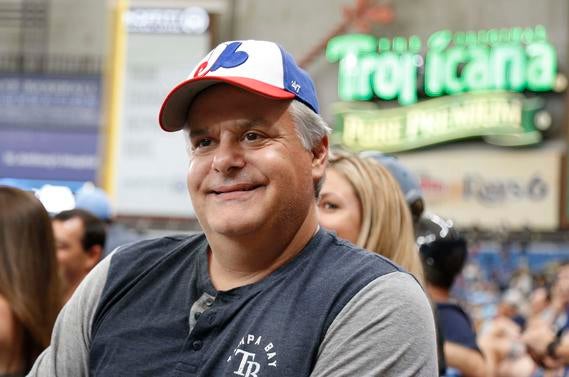
In June, the Rays received permission from MLB to pursue a split-city agreement with Montreal. The idea, as explained by owner Stuart Sternberg, would entail the Rays playing the early portion of their schedule in St. Petersburg before hopping on a flight to Montreal to finish out the season. In Sternberg's vision, both St. Petersburg and Montreal would help facilitate brand-new open-air stadiums (and the union would permit their members to be tasked with swapping countries halfway through the season, the way they might change bats or cleats). How Sternberg intends to escape the use agreement with the city of St. Petersburg, which runs through 2027, is anyone's guess.
Who Sternberg hopes will deliver him and the Rays north of the border has come into clearer focus. Stephen Bronfman, the son of Expos founder Charles Bronfman, recalls eating peanuts during batting practice whenever he'd attend games with his father. Now in his 50s, and nearly 30 years removed from the family selling the Expos, Bronfman has resurfaced as the champion of a movement started by former Expos player Warren Cromartie. The goal is simple: return MLB to the City of Saints for the first time since 2004.
Bronfman's inclusion in Sternberg's scheme is compelling for various reasons. There are the obvious connections to the sport and to Montreal, but there's also a long-forgotten report in the New York Times where Murray Chass noted MLB approached Bronfman about taking over the franchise before the league handed the reins to Jeffrey Loria. Bronfman declined to grant the Expos salvation, begetting Loria's ownership, which wrought destruction to the team. After Loria and John Henry completed an ownership double-switch, involving the then-Florida Marlins and Boston Red Sox, Loria's group was allowed to take most of the franchise with them to Miami -- even the computers.
Before the Expos were put to rest, Bronfman's father and 13 other Canadian companies sued Bud Selig, Bob DuPuy, Loria and David Samson on the grounds of violating the Racketeer Influenced and Corrupt Organizations Act. The Canadian group alleged Selig and crew had conspired to "eliminate Major League Baseball in Montreal." An arbitration panel later acknowledged Montreal had the right to feel betrayed -- but ruled in Selig's favor. Selig took the RICO case "very personally," per Bronfman, and it damaged his longstanding friendship with Charles. Bronfman said he visited Selig toward the the end of his tenure and apologized "for the family" and "for what happened over that time." It was then when Selig told Bronfman he wanted to rekindle his friendship with Charles -- and "at some point to see Major League Baseball back in Montreal." The seed for a Montreal return was planted.
However the seed may bloom, Bronfman has a checklist for what makes a successful franchise. He believes there are five legs, much like a stool. Those five elements include very strong mixed-used development, great media partnership, strong local corporate support, great fan base, and very well managed business. Bronfman does not present these legs as being ordinal in nature, yet he might be nearing a deal to secure No. 1 -- the mixed-use development. Recently, Bronfman reached an agreement with a developer to pursue land at the Peel Basin. In theory, this could be the future home of the Rays, the Expos, or whatever they're called (the name is unimportant to him).
As with Portland, there is logistical red tape to cut through before Montreal would be ready to play ball. One advantage Montreal would seem to have is Bronfman's designation about how public financing would be unnecessary. He has offered a follow-up comment, suggesting other kinds of help would be required. What does that mean? "You need infrastructural help, you need zoning, you do need some financial help ... when I made that statement about no dollars needed, direct investment into the team, that was more from the city's point of view.
"We had not had financing discussions with the province but the province would be involved in helping the overall stadium project come together. We also have a length around the land that's a private public partnership of a light rail system that'll give great access to public transit to the site. So, there's a lot of things that government would help with," Bronfman said. "You know some potential financing on the development, but those all have terms and they have the paybacks for the province and city. So, that's not certain, but direct cash into any project is not needed."
This could in time prove true of Bronfman's efforts in Montreal. In other markets, new and old, teams continue to find ways to wring public financing from local governments.
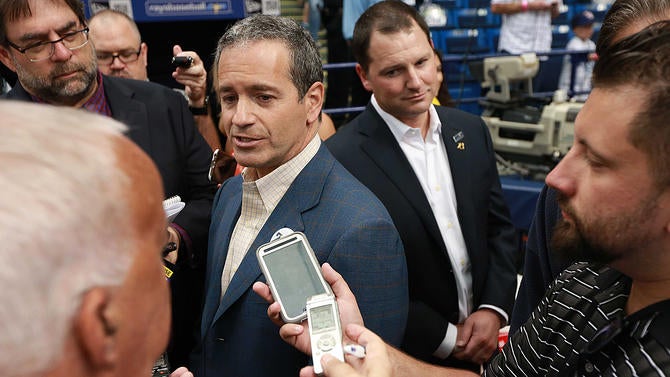
Just as the falcon cannot hear the falconer, oftentimes city officials cannot see the truth through sports' teams smokescreens.
Neil deMause, who wrote the book and maintains the website about stadium swindles, can recall countless ridiculous schemes orchestrated by team owners to land a new stadium or arena. Eventually, Sternberg's proposed two-city solution might take the prize for the most ludicrous attempt at extracting leverage. For now, one egregious example was when the Pittsburgh Penguins were politicking for a new igloo. Owner and franchise icon Mario Lemieux was spotted in Kansas City and Las Vegas, fueling speculation the Penguins were shopping around their residency. Just as soon as the Penguins secured a rink in Pittsburgh, Lemieux dismissed those sightings elsewhere by saying: "Those trips to Kansas City and Vegas and other cities was just to go and have a nice dinner and come back."
Owners like Lemieux and Reinsdorf have published pages from the owners' playbook, and have clowned politicians in the process. So, why do cities continue to sign off on stadium subsidies? There is no one answer, but there are a number of theories and potential explanations, beginning upfront with misleading economic impact studies.
In interviews with Cheek and Bronfman, both referenced studies conducted by Conventions, Sports & Leisure International. Purportedly independent in nature, CSL is a subsidy of Legends Hospitality, a joint venture between the Dallas Cowboys and New York Yankees -- two organizations who benefit from new stadiums. DeMause refers to CSL as a "conflict of interest made flesh." Conversations with employees at CSL and similar firms have revealed to him the internal mandate is "not to provide an independent economic analysis," but "to provide something that will justify what the client wants." Like, say, an expensive ballpark.
Victor Matheson, a professor at Holy Cross and an editor for the Journal of Sports Economics, offers advice for anyone who comes across one of these economic impact reports: move the decimal to the left. For example, Portland's ballpark is estimated to result in an impact of $333 million per year over 30 years, or $10 billion. Using Matheson's rule of thumb, those figures would be shaved to $33 million per season, or $1 billion over 30 years -- a more realistic, if perhaps still juiced projection about stadiums' impact on the local economy.
Countless studies, of greater rigor and legitimacy than the ones offered by consulting firms, have over the years shown stadiums are poor investments for cities. Using bed taxes or withholding player income taxes to fund a stadium seems harmless -- except for the opportunity cost involved. Every dollar spent on a stadium is one not spent on schools, hospitals, infrastructure -- institutions likelier to impact the quality of life for a greater number of people than a new ballpark. What economic impact stadiums do offer is often misunderstood, too. Economists refer to the "substitution effect" in these cases. It's similar to opportunity cost. If a family of four is spending money at the ballpark, it won't be spending money at the movies. Stadiums aren't value creators so much as they are value re-distributors, from other local businesses to themselves, often without the best-compensated employees pumping those dollars back into the economy. One study even found a local economy improved after a team left the area.
Obviously there are non-financial reasons to build a stadium -- the team they house can be a source of civic pride, and can bring the community together -- but, for the most part, the math suggests they're more hype than substance. Governments seem to be catching on. Matheson pointed out the percentage of public financing in new stadiums has dipped since the 2008 recession. Some politicians, including presidential hopeful Cory Booker, have attempted to end federal subsidies for sports stadiums. There are many who hope the practice remains legal, however. "Just because stadiums are a bad deal for cities as a whole, doesn't mean that there aren't special interests that stand to make a lot of money," Matheson said. Among those groups: construction companies, property owners, lawyers, and lobbyists -- a D.C. group once paid longtime baseball executive Peter Bavasi more than $200,000 to network on their behalf.
The officials who cough up the sweetest deals are falling victim to various forces, beginning with the edifice complex. As deMause explained, "Local officials like to build things they can point at." When not indulging their inner Robert Moses, the politicians may fear a lost team will result in a lost election. (Leeds has started researching if this is a true or merely an urban legend.) And, because sports owners are often powerful people, they can manipulate other influencers and businesses into cajoling the mayor (or whomever) on their behalf -- leading to a decision more beneficial for a billionaire than their constituency. No wonder the late Jim Bouton once wrote, "The fiercest competition in sports these days is not between teams or leagues, but between governments and their own citizens."
As with stores, teams are always having to adjust their nudges as cities grow wiser. Some of the more common tricks rolled out include the threat of relocation (or, in the case of expansion markets, discontinuation of the effort); vague commentary about how a new stadium will help a team -- the "how" part is often omitted; and pitching a new ballpark as a venue with 365-day use potential. Stadiums built for baseball, it turns out, are often good for only baseball. Some teams may even lie and suggest their fancy sandlot will pay for itself. The evidence says: not likely. "The greatest misconception about sports stadiums and arenas is that they make money," deMause said. "I would guesstimate 80 to 90 percent of new buildings do not pay for their own construction costs, let alone have any money left over afterward. So, if you just looked at them as, would this thing pay for itself? The answer is no.
"They're not looking for stadiums because they want stadiums, they're looking for stadiums because they want the subsidies. If you go to the state legislature and say, 'Can I have half a billion dollars because I'm a rich guy and I really want to have another half a billion dollars?' the state legislature will say, 'Yeah, no, we're not really in the business of that.' If you go to the state legislature and say, 'I need a new stadium because that's what I need to make my business successful and make this city great and I need half a billion dollars so I can do it,' they say, 'Let's talk.'"
The one way a community can avoid losing the game is to not engage by the game's rules.
Were "Family Feud" (or a sports-themed derivative) to ask 100 people what Pat Williams was best known for, the top answers would likely be a four-time NBA general manager, a renowned good-luck charm for the draft lottery and perhaps a best-selling author. Some may know him as a former professional baseball player, but not many would be aware of his history as an award-winning minor-league executive, or his efforts to land the city of Orlando a big-league team.
Before the Marlins and Rays were awarded to Miami and St. Petersburg, Williams spearheaded multiple attempts at bringing baseball to Florida. He still has the napkin on which he sprawled his original pitch to William duPont, then the owner of the Orlando Magic. The efforts didn't succeed, and despite the napkin's implication, not for a lack of sophistication. Orlando's first campaign went beyond the normal scope. The group purchased a minor-league team to gain the territorial rights and renamed them the SunRays to get jump start on branding. Further, they named a manager (Bob Boone) and multiple front-office personnel (including Bobby Richardson as a consultant). The hope, Williams said, was that MLB would see how serious they were about their pursuit and reward them for their initiative.
Baseball did not reward Orlando. Rather, the group fell short for various reasons, beginning with consternation about duPont being replaced as the money person by Rich deVos. Williams recalls he was once told by an official they chose Miami over Orlando because when they took a helicopter ride over both cities, they noticed only tree tops in Orlando, as opposed to house tops in Miami. ("Under the tree tops were house tops," Williams replied.) Later, Williams said baseball granted St. Petersburg a team to prevent lawsuits stemming from the city's past pursuits.
When Williams is asked what he'd advise current groups jockeying for a team, he ticks off the same three categories everyone else identifies as vital. He first says to make sure the owner, or group leader, has deep pockets. He then talks about the importance of a stadium, or a plan for a stadium. At last, he addresses the community aspect, noting how selling season-ticket deposits door-to-door helped Orlando land the Magic in the first place. Williams then seems to add a fourth aspect to his list: himself -- or, a proxy who is enthusiastic and committed. In his own words, someone who is "going to so many chicken lunches" to woo the community "that at night he doesn't sleep, he roosts."
If Williams' checklist is indicative of what MLB looks for -- and it is -- then the efforts in Portland, Montreal and other cities stand a chance of being awarded a franchise in the coming years, or whenever Manfred opts for expansion. Conversely, the burgeoning effort in Raleigh, North Carolina, is more far-fetched. "MLB Raleigh," as its called, doesn't have an owner or investors lined up. It doesn't have a stadium, or a land agreement in place. It hasn't schmoozed with local politicians or Major League Baseball. And the wildest part: All of this is by design. Raleigh's group doesn't want to win over investors or the league -- it wants to win over the community first before pushing onward.
The point guard behind Raleigh's push is Lou Pascucci, a 35-year-old user experience designer for IBM. Pascucci was born in New Jersey, but moved to North Carolina when he was in the fourth grade. He's adamant the Raleigh-Durham area is a legitimate baseball market -- one who can support the Durham Bulls and a nearby big-league team, the way Seattle supports the Mariners and the Tacoma Rainiers. Pascucci's case extends beyond emotion. Years ago, he and his friends wondered what they were missing whenever Charlotte was named and Raleigh was snubbed as a potential expansion market. So, they collected and analyzed the data -- and did nothing with any of it until a few years passed. "One day, when Manfred started to talk about expansion two years ago, we got back together and we started to say, 'Look, it doesn't seem like there's any movement in Raleigh. But these numbers have to get out there,'" Pascucci said. "We came together and decided to run a campaign -- and not do what they usually do."
The statistical analysis conducted by Pascucci's group extends beyond evaluating population and TV market numbers. Some of their findings were gleaned from the census, using the "metropolitan statistical area" and the "combined statistical area." They host a collection of their most marketable tidbits on their website, highlighting how Raleigh-Durham compares favorably with a number of places that already have MLB teams; how Raleigh was the "second-fastest growing metro area from 2010-17", behind Austin-Round Rock, Texas; and how Raleigh is the "No. 1 richest metro area in the continental U.S. without a MLB team within 100 miles."
The traditional approach would have been to package the numbers and use them to attract investors. Pascucci and his friends have instead taken a different approach; a healthier one, albeit one less likely to land them a team.
Rather than build from the top-down, Pascucci and his friends are organizing from the bottom-up. This entails, among other things, staging rallies and selling merchandise. Grifting is all the rage in 2019, but that isn't the case here. The money isn't going into Pascucci's pockets, or any individual's wallet or bank account. "All the profits that we're making off this are going back into the community to help fix up baseball fields and to help promote baseball in underserved areas of our community," he said. "We don't want to seem like Raleigh is just another place with some decent numbers that wants a Major League Baseball team; we want to put our money where our mouth is."
There is some guile to MLB Raleigh's altruism. For instance, the group has collaborated with the Boys and Girls Club in part due to MLB's fondness for the organization -- as a way of showing they're big-league in some ways, if not others. The buy-in from other aspects of the Raleigh-Durham community seems to have heartened Pascucci, too, who notes how designers and construction companies -- the same ones renovating downtown Raleigh -- are donating their time, passion, and talents for free to build dugouts and work on the fields using supplies purchased by the group.
Pascucci acknowledges the thinking behind the Raleigh campaign is a departure from what's happening with Cheek in Portland and Bronfman in Montreal, among other prospective owners in potential markets. In a follow-up email, he wrote how MLB Raleigh wants to "become the antithesis of what the business of baseball has become." He continued: "The game is not dying because of the pace or because the rules need adjusting. It's dying because the very things that made it special are being overshadowed by the very thing every American is sick of: big business and greed."
To Pascucci's point, the expansion effort is a business within itself. Cheek, Bronfman, and others may be invested in their communities -- and the people within them. But baseball is not -- no more so than as potential consumers who can help make the league more money. What Raleigh is doing, focusing on winning over the fans rather than the suits, feels like the preferred approach. It's also an approach unlikely to succeed -- if success is measured by landing a team. If success is measured by another rubric, like instilling a love of baseball in the community -- and doing so without the bitter aftertaste often left by the business element -- then perhaps Raleigh is the winner of the bunch. "If for some reason it doesn't work out, then we've helped promote the game in our community," Pascussi said. "That's what works, that's what we've been talking about since Day 1: This is a baseball market. This is a baseball town."













